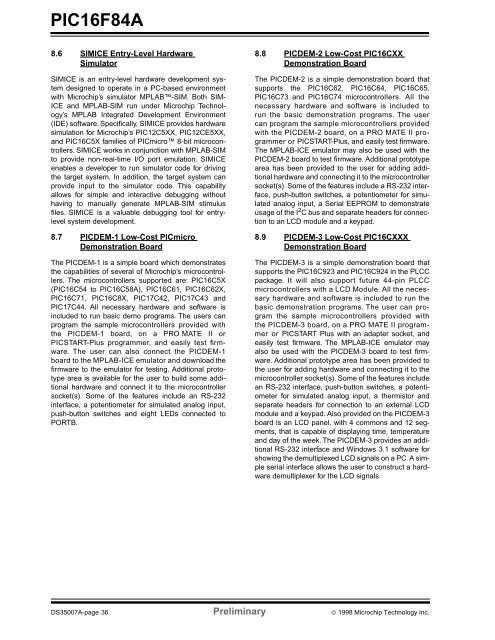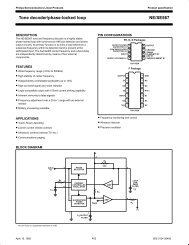PIC16F84A 18-pin Enhanced Flash/EEPROM 8-Bit MCU Data Sheet
PIC16F84A 18-pin Enhanced Flash/EEPROM 8-Bit MCU Data Sheet
PIC16F84A 18-pin Enhanced Flash/EEPROM 8-Bit MCU Data Sheet
You also want an ePaper? Increase the reach of your titles
YUMPU automatically turns print PDFs into web optimized ePapers that Google loves.
<strong>PIC16F84A</strong>8.6 SIMICE Entry-Level HardwareSimulatorSIMICE is an entry-level hardware development systemdesigned to operate in a PC-based environmentwith Microchip’s simulator MPLAB-SIM. Both SIM-ICE and MPLAB-SIM run under Microchip Technology’sMPLAB Integrated Development Environment(IDE) software. Specifically, SIMICE provides hardwaresimulation for Microchip’s PIC12C5XX, PIC12CE5XX,and PIC16C5X families of PICmicro 8-bit microcontrollers.SIMICE works in conjunction with MPLAB-SIMto provide non-real-time I/O port emulation. SIMICEenables a developer to run simulator code for drivingthe target system. In addition, the target system canprovide input to the simulator code. This capabilityallows for simple and interactive debugging withouthaving to manually generate MPLAB-SIM stimulusfiles. SIMICE is a valuable debugging tool for entrylevelsystem development.8.7 PICDEM-1 Low-Cost PICmicroDemonstration BoardThe PICDEM-1 is a simple board which demonstratesthe capabilities of several of Microchip’s microcontrollers.The microcontrollers supported are: PIC16C5X(PIC16C54 to PIC16C58A), PIC16C61, PIC16C62X,PIC16C71, PIC16C8X, PIC17C42, PIC17C43 andPIC17C44. All necessary hardware and software isincluded to run basic demo programs. The users canprogram the sample microcontrollers provided withthe PICDEM-1 board, on a PRO MATE II orPICSTART-Plus programmer, and easily test firmware.The user can also connect the PICDEM-1board to the MPLAB-ICE emulator and download thefirmware to the emulator for testing. Additional prototypearea is available for the user to build some additionalhardware and connect it to the microcontrollersocket(s). Some of the features include an RS-232interface, a potentiometer for simulated analog input,push-button switches and eight LEDs connected toPORTB.8.8 PICDEM-2 Low-Cost PIC16CXXDemonstration BoardThe PICDEM-2 is a simple demonstration board thatsupports the PIC16C62, PIC16C64, PIC16C65,PIC16C73 and PIC16C74 microcontrollers. All thenecessary hardware and software is included torun the basic demonstration programs. The usercan program the sample microcontrollers providedwith the PICDEM-2 board, on a PRO MATE II programmeror PICSTART-Plus, and easily test firmware.The MPLAB-ICE emulator may also be used with thePICDEM-2 board to test firmware. Additional prototypearea has been provided to the user for adding additionalhardware and connecting it to the microcontrollersocket(s). Some of the features include a RS-232 interface,push-button switches, a potentiometer for simulatedanalog input, a Serial <strong>EEPROM</strong> to demonstrateusage of the I 2 C bus and separate headers for connectionto an LCD module and a keypad.8.9 PICDEM-3 Low-Cost PIC16CXXXDemonstration BoardThe PICDEM-3 is a simple demonstration board thatsupports the PIC16C923 and PIC16C924 in the PLCCpackage. It will also support future 44-<strong>pin</strong> PLCCmicrocontrollers with a LCD Module. All the necessaryhardware and software is included to run thebasic demonstration programs. The user can programthe sample microcontrollers provided withthe PICDEM-3 board, on a PRO MATE II programmeror PICSTART Plus with an adapter socket, andeasily test firmware. The MPLAB-ICE emulator mayalso be used with the PICDEM-3 board to test firmware.Additional prototype area has been provided tothe user for adding hardware and connecting it to themicrocontroller socket(s). Some of the features includean RS-232 interface, push-button switches, a potentiometerfor simulated analog input, a thermistor andseparate headers for connection to an external LCDmodule and a keypad. Also provided on the PICDEM-3board is an LCD panel, with 4 commons and 12 segments,that is capable of displaying time, temperatureand day of the week. The PICDEM-3 provides an additionalRS-232 interface and Windows 3.1 software forshowing the demultiplexed LCD signals on a PC. A simpleserial interface allows the user to construct a hardwaredemultiplexer for the LCD signals.DS35007A-page 36 Preliminary © 1998 Microchip Technology Inc.



